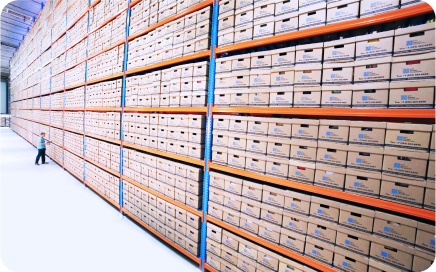Warehouse Automation: Your Path to a Future-Proof Business
By Rackbeat May 31, 2024

The Role of Technology in Future Warehouse Management
Technology is advancing faster than you can move your mouse. This means that you constantly get new opportunities to streamline your business while your customers expect you to have done it yesterday.
Here, automation has become a key term.
If you want to keep up with your competitors, save a lot of time in your workflows and satisfy your customers, you need to cut as many manual processes as possible and introduce more automation.
Especially within the realm of inventory management, automation increasingly plays a critical role in creating seamless operations and reducing your costs.
In this post, we will explore how warehouse automation can elevate your business and explain the key role that software like a WMS, Warehouse Management System, plays in this regard.
So let’s dive into the benefits of automating your warehouse.
The Benefits of Warehouse Automation
- Increased Efficiency: Automation helps eliminate many of the time-consuming tasks that employees previously had to handle manually. This includes everything from order management to restocking and shipping goods.
- Reduced Error Rate: Human errors are a natural part of any manual warehouse process, but with automation, these errors are significantly minimized.
- Cost Savings: Although there is some investment associated with implementing automation technologies, the long-term savings can be substantial. Reduced personnel costs, less waste and faster operations contribute to more cost-effective operations.
These are three quick benefits that come with automating your warehouse. But what should you be aware of before you let automation take full control?
Implementing Warehouse Automation
Taking the step towards warehouse automation requires a clear understanding of your current needs and future goals. Therefore, you should consider the following points when you are about to embark on automating your warehouse:
- Assess Your Needs: Analyze your current warehouse processes and identify areas where automation could bring the greatest benefits.
- Choose the Right Technology: There are many different forms of automation technology. Choose the solution that best matches your company’s size and budget.
- Plan the Implementation: A successful implementation requires careful planning. Consider how the integration with your existing systems will take place and how employees will be trained to use the new equipment.
- Measure Success: After implementation, it is important to measure the system’s effectiveness. Monitor key indicators such as inventory turnover, order processing times and customer satisfaction to ensure the technology meets expectations.
When you have a clear plan for implementation, it is time to look more closely at the specific tools that can help you achieve a more automated warehouse operation. Here are three essential technologies that can make a big difference in the efficiency of your warehouse operations and order management.
Three Tools for a More Automated Warehouse
To achieve effective warehouse automation, there are particularly three tools that can make a big difference for you: warehouse management systems (WMS), handheld scanners for picking and packing, and warehouse management apps:
1. Warehouse Management Systems (WMS)
A WMS automatically updates your inventory whenever a sale is made, a purchase is made, or an inventory adjustment is made. This ensures that your inventory data is always accurate, reducing the risk of out-of-stock items and overfilled shelves.
At the same time, a WMS continuously collects your data, such as your financial inventory value, your purchases, and your sales. This enables you to assess everything from inventory turnover, which products sell best and when to order new goods.
2. Handheld Scanners for Picking and Packing
Handheld scanners can significantly increase the speed and accuracy of your order processing. They ensure that every step in the order process is documented and verified in real-time, ensuring that the right products are picked and packed correctly. Moreover, they can be connected to most WMSs, so your inventory is updated as items are scanned.
3. Warehouse Management Apps
Warehouse management apps offer a wide range of features that allow you to manage your warehouse directly from your smartphone. Here are some of the key features you can expect in warehouse management apps:
Efficient Picking and Packing
You can speed up picking and packing work considerably, as you can complete your sales orders directly from your smartphone. Picking lists and packing slips are at your fingertips, so you don’t have to spend time going back and forth from the laptop or computer to the warehouse shelf.
Quick Inventory Counting and Adjustment
Most warehouse management apps allow you to count and adjust the inventory from the floor. This makes it easy to get an overview of the items your company has on hand. With a direct connection to your warehouse management system, the information will automatically be available in the overall inventory overview.
Receiving Goods and Overview of Orders
When goods arrive at your warehouse, you can register them directly from your mobile, updating your inventory. You also get a clear overview of your purchase orders, suppliers, and desired delivery dates.
When you have considered these tools, the next step is to think about how automation can be more extensively integrated into your business to ensure a good and profitable future.
Future-Proof Your Business with Warehouse Automation
Automating your warehouse is not just a way to improve efficiency; it is a way to future-proof your business, save a lot of time, and reduce the risk of errors in your daily workflows. By leveraging modern technology, you can transform your warehouse into a smooth, error-free operation that enhances your entire business. If you are ready to take your warehouse management to the next level, automation could be your next big investment.
For example, you can read more about Rackbeat’s inventory management system or try our free trial.



